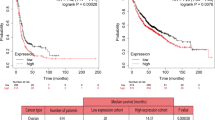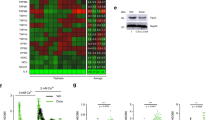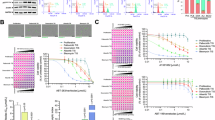Abstract
Cellular senescence is a fundamental biological process that has profound implications in cancer development and therapeutics, but the underlying mechanisms remain elusive. Here we show that carnitine palmitoyltransferase 1C (CPT1C), an enzyme that catalyzes carnitinylation of fatty acids for transport into mitochondria for β-oxidation, plays a major role in the regulation of cancer cell senescence through mitochondria-associated metabolic reprograming. Metabolomics analysis suggested alterations in mitochondria activity, as revealed by the marked decrease in acylcarnitines in senescent human pancreatic carcinoma PANC-1 cells, indicating low CPT1C activity. Direct analyses of mRNA and protein show that CPT1C is significantly reduced in senescent cells. Furthermore, abnormal mitochondrial function was observed in senescent PANC-1 cells, leading to lower cell survival under metabolic stress and suppressed tumorigenesis in a mouse xenograft model. Knock-down of CPT1C in PANC-1 cells induced mitochondrial dysfunction, caused senescence-like growth suppression and cellular senescence, suppressed cell survival under metabolic stress, and inhibited tumorigenesis in vivo. Further, CPT1C knock-down suppressed xenograft tumor growth in situ. Silencing of CPT1C in five other tumor cell lines also caused cellular senescence. On the contrary, gain-of-function of CPT1C reversed PANC-1 cell senescence and enhanced mitochondrial function. This study identifies CPT1C as a novel biomarker and key regulator of cancer cell senescence through mitochondria-associated metabolic reprograming, and suggests that inhibition of CPT1C may represent a new therapeutic strategy for cancer treatment through induction of tumor senescence.
Similar content being viewed by others
Log in or create a free account to read this content
Gain free access to this article, as well as selected content from this journal and more on nature.com
or
References
Idle JR, Gonzalez FJ. Metabolomics. Cell Metab 2007;6(5):348–51.
Chien Y, Scuoppo C, Wang X, Fang X, Balgley B, Bolden JE, et al. Control of the senescence-associated secretory phenotype by NF-kappaB promotes senescence and enhances chemosensitivity. Genes Dev. 2011;25(20):2125–36
Nogueira V, Hay N. Molecular pathways: reactive oxygen species homeostasis in cancer cells and implications for cancer therapy. Clin Cancer Res 2013;19(16):4309–14.
Vina J, Gomez-Cabrera MC, Borras C, Froio T, Sanchis-Gomar F, Martinez-Bello VE, et al. Mitochondrial biogenesis in exercise and in ageing. Adv Drug Deliv Rev 2009;61(14):1369–74.
Ide T, Tsutsui H, Hayashidani S, Kang D, Suematsu N, Nakamura K, et al. Mitochondrial DNA damage and dysfunction associated with oxidative stress in failing hearts after myocardial infarction. Circ Res 2001;88(5):529–35.
Simonsen JL, Rosada C, Serakinci N, Justesen J, Stenderup K, Rattan SI, et al. Telomerase expression extends the proliferative life-span and maintains the osteogenic potential of human bone marrow stromal cells. Nat Biotechnol 2002;20(6):592–6.
Xu D, Neville R, Finkel T. Homocysteine accelerates endothelial cell senescence. FEBS Lett 2000;470(1):20–24.
Panopoulos AD, Yanes O, Ruiz S, Kida YS, Diep D, Tautenhahn R, et al. The metabolome of induced pluripotent stem cells reveals metabolic changes occurring in somatic cell reprogramming. Cell Res 2012;22(1):168–77.
Wu LE, Gomes AP, Sinclair DA. Geroncogenesis: metabolic changes during aging as a driver of tumorigenesis. Cancer cell 2014;25(1):12–19.
Bremer J. Carnitine—metabolism and functions. Physiol Rev 1983;63(4):1420–80.
Wu R, Wu Z, Wang X, Yang P, Yu D, Zhao C, et al. Metabolomic analysis reveals that carnitines are key regulatory metabolites in phase transition of the locusts. Proceedings of the National Academy of Sciences of the United States of America. 2012;109(9):3259–63
Nguyen D, Samson SL, Reddy VT, Gonzalez EV, Sekhar RV. Impaired mitochondrial fatty acid oxidation and insulin resistance in aging: novel protective role of glutathione. Aging cell 2013;12(3):415–25.
Sanchez-Macedo N, Feng J, Faubert B, Chang N, Elia A, Rushing EJ, et al. Depletion of the novel p53-target gene carnitine palmitoyltransferase 1C delays tumor growth in the neurofibromatosis type I tumor model. Cell Death Differ. 2013;20(4):659–68
Roninson IB. Tumor cell senescence in cancer treatment. Cancer Res 2003;63(11):2705–15.
Zhang H, Gao Y, Sun J, Fan S, Yao X, Ran X et al. Optimization of lipid extraction and analytical protocols for UHPLC-ESI-HRMS-based lipidomic analysis of adherent mammalian cancer cells. Anal Bioanal Chem. 2017;409:5349-58.
Zaugg K, Yao Y, Reilly PT, Kannan K, Kiarash R, Mason J, et al. Carnitine palmitoyltransferase 1C promotes cell survival and tumor growth under conditions of metabolic stress. Genes Dev. 2011;25(10):1041–51
Rinaldi C, Schmidt T, Situ AJ, Johnson JO, Lee PR, Chen KL, et al. Mutation in CPT1C associated with pure autosomal dominant spastic paraplegia. JAMA Neurol. 2015;72(5):561–70
Wolfgang MJ, Kurama T, Dai Y, Suwa A, Asaumi M, Matsumoto S, et al. The brain-specific carnitine palmitoyltransferase-1c regulates energy homeostasis. Proc Natl Acad Sci USA. 2006;103(19):7282–7
Carrasco P, Sahun I, McDonald J, Ramirez S, Jacas J, Gratacos E, et al. Ceramide levels regulated by carnitine palmitoyltransferase 1C control dendritic spine maturation and cognition. J Biol Chem. 2012;287(25):21224–32
Shimizu N, Chikahisa S, Nishi Y, Harada S, Iwaki Y, Fujihara H, et al. Maternal dietary restriction alters offspring’s sleep homeostasis. PloS One. 2013;8(5):e64263
Virmani A, Pinto L, Bauermann O, Zerelli S, Diedenhofen A, Binienda ZK, et al. The carnitine palmitoyl transferase (CPT) system and possible relevance for neuropsychiatric and neurological conditions. Mol Neurobiol. 2015;52(2):826–36
Sun N, Youle RJ, Finkel T. The mitochondrial basis of aging. Mol Cell 2016;61(5):654–66.
Gallage S, Gil J. Mitochondrial dysfunction meets senescence. Trends Biochem Sci 2016;41(3):207–9.
Wiley CD, Velarde MC, Lecot P, Liu S, Sarnoski EA, Freund A, et al. Mitochondrial dysfunction induces senescence with a distinct secretory phenotype. Cell Metab. 2016;23(2):303–14
Liu Y, Nguyen P, Baris TZ, Poirier MC. Molecular analysis of mitochondrial compromise in rodent cardiomyocytes exposed long term to nucleoside reverse transcriptase inhibitors (NRTIs). Cardiovasc Toxicol 2012;12(2):123–34.
Hiona A, Leeuwenburgh C. The role of mitochondrial DNA mutations in aging and sarcopenia: implications for the mitochondrial vicious cycle theory of aging. Exp Gerontol 2008;43(1):24–33.
Linnane AW, Marzuki S, Ozawa T, Tanaka M. Mitochondrial DNA mutations as an important contributor to ageing and degenerative diseases. Lancet (London, England) 1989;1(8639):642–5.
Chen Y, Wang Y, Huang Y, Zeng H, Hu B, Guan L, et al. PPARalpha regulates tumor cell proliferation and senescence via a novel target gene carnitine palmitoyltransferase 1C. Carcinogenesis. 2017;38(4):474–83.
Gao XF, Chen W, Kong XP, Xu AM, Wang ZG, Sweeney G, et al. Enhanced susceptibility of Cpt1c knockout mice to glucose intolerance induced by a high-fat diet involves elevated hepatic gluconeogenesis and decreased skeletal muscle glucose uptake. Diabetologia. 2009;52(5):912–20.
Acknowledgements
The authors are grateful to Drs. Jun Du, Xiaoyan Shen, and Jun Li from Sun Yat-sen University for generously providing various cell lines. This study was supported by the Natural Science Foundation of China (Grants: 81522047, 81573489, 81373470, 81320108027), the 111 Project (Grant: B16047), the Key Laboratory Foundation of Guangdong Province (Grant: 2011A060901014), and the Guangzhou Health Care Collaborative Innovation Program (Grant: 201508020250).
Author contributions
HB, MH, PH and YW designed the experiments, YW, YC, LG, HZ and YH conducted the experiments, YW and HB performed data analysis, YW, HB, FJG, CHJ, AY, and PH wrote the paper, ZW, SY, YW, PC and XF contributed to new reagents or analytical tools.
Author information
Authors and Affiliations
Corresponding author
Ethics declarations
Conflict of interest
The authors declare that they have no competing interests.
Additional information
Edited by G. Melino
Electronic supplementary material
Rights and permissions
About this article
Cite this article
Wang, Y., Chen, Y., Guan, L. et al. Carnitine palmitoyltransferase 1C regulates cancer cell senescence through mitochondria-associated metabolic reprograming. Cell Death Differ 25, 735–748 (2018). https://doi.org/10.1038/s41418-017-0013-3
Received:
Revised:
Accepted:
Published:
Issue date:
DOI: https://doi.org/10.1038/s41418-017-0013-3
This article is cited by
-
METTL3 promotes cellular senescence of colorectal cancer via modulation of CDKN2B transcription and mRNA stability
Oncogene (2024)
-
Genetically predicted gut bacteria, circulating bacteria-associated metabolites and pancreatic ductal adenocarcinoma: a Mendelian randomisation study
Scientific Reports (2024)
-
PRRG4 regulates mitochondrial function and promotes migratory behaviors of breast cancer cells through the Src-STAT3-POLG axis
Cancer Cell International (2023)
-
To be or not to be a fat burner, that is the question for cpt1c in cancer cells
Cell Death & Disease (2023)
-
Histochemical, Immunohistochemical, and Biochemical Investigation of the Effect of Resveratrol on Testicular Damage Caused by Methotrexate (MTX)
Reproductive Sciences (2023)



